Do you have a question about the Olympus FE-25 and is the answer not in the manual?
Access camera settings through menus for photography, playback, date/time, and screen display.
Select image quality for printing or web viewing based on resolution and compression settings.
Adjust white balance settings for different lighting conditions like daylight, cloudy, tungsten, or fluorescent.
Adjust ISO sensitivity to control image brightness in low light, balancing noise and speed.
Stitch multiple photos together to create a wide panoramic image using bundled software.
Start an automatic slideshow of images stored on the camera's memory or card.
Delete individual images or all images from the camera's memory or memory card.
Set print reservations (DPOF) to easily print images without a computer.
Rotate images 90 degrees clockwise or counter-clockwise for correct orientation.
Attach the camera strap securely to prevent it from becoming loose.
Insert batteries and xD-Picture Card (sold separately) into the camera.
Replace batteries when the error message indicating low battery is displayed.
Insert the microSD card into its microSD Adapter.
Insert the microSD Adapter into the camera.
Instructions for safely removing the xD-Picture Card from the camera.
Instructions for safely removing the microSD card from the adapter.
Learn to photograph using Program Auto (P) mode, allowing adjustments to exposure and white balance.
View images while in photography mode, allowing quick review before shooting.
Instructions on how to record videos using the camera's video mode.
Select Scene Mode (SCN) to automatically optimize settings for specific photographic scenes.
Use Auto mode for automatic scene detection and optimal shooting settings.
Adjust the shooting range using the zoom buttons (W/T) for optical and digital zoom.
Select flash functions like Auto, Red-eye reduction, and Fill-in for various shooting conditions.
Switch between index view for quick selection and close-up view for checking image details.
Move the area of visualization to rotate the image while in close-up view.
Completely erase all image data from the internal memory or memory card.
Back up image data from the internal memory to the memory card.
Select the menu and error message language displayed on the monitor.
Adjusts the camera's CCD and image processing function for optimal results.
Print images directly from the camera to a PictBridge-compatible printer.
Print images using the printer's default settings for quick and easy output.
Set print reservations for individual images, specifying quantity and date/time options.
Check system requirements and install the OLYMPUS Master 2 software.
Connect the camera to your computer using the USB cable for data transfer.
Troubleshoot common camera issues related to battery, memory, and button operations.
Tips for viewing the monitor in different conditions, including condensation and visibility issues.
Troubleshoot issues where date and time settings revert to default.
Tips on camera noises during operation and other general usage advice.
Troubleshoot issues related to the cartridge/battery compartment, such as open doors or empty batteries.
Resolve problems with camera-to-computer or camera-to-printer connections, ink, or paper.
Address errors related to memory cards, internal memory full, or uneditable images.
Tips for focusing on off-center objects or subjects that may challenge autofocus.
Reduce blur from camera shake using stabilization modes or high ISO sensitivity.
Achieve correct exposure and brightness, especially in backlit scenes or for specific subjects.
Achieve consistent color tones by selecting appropriate white balance or using fill-in flash.
Achieve sharper images by using optical zoom and low ISO sensitivity.
Conserve battery life by avoiding unnecessary operations like zoom or frequent button presses.
Proper cleaning and handling procedures for the camera's exterior, monitor, and lens.
Guidelines for using appropriate batteries and avoiding hazards like leakage or explosion.
Check the memory indicator to confirm if internal memory or the card is being used.
Format new or previously used cards using the camera's formatting function.
Avoid interrupting card operations to prevent data corruption or damage.
Avoid touching the microSD adapter's contact area to prevent reading failures.
Follow operating instructions, clean with a soft cloth, and use only recommended accessories.
Avoid flammable gases, flash use near people, and keep away from dust or moisture.
Handle with care to avoid overheating, low-temperature burns, or damage from liquids.
Follow instructions for battery use to prevent leakage, overheating, fire, or explosion.
Keep batteries dry, use only recommended types, and avoid mixing or recharging incorrect types.
Handle batteries carefully after use, remove them for storage, and avoid exposing them to extreme temperatures.
Use Olympus NiMH batteries only, charge sets together, and avoid non-rechargeable or mixed types.
Olympus disclaims warranties on written material and software, limiting liability for damages.
Unauthorized reproduction or use of registered material is prohibited and may violate copyright laws.
FCC compliance statement and contact information for Olympus Imaging America Inc.
Digital Class B equipment compliance with Canadian Interference Regulations.
Details exclusions from warranty, including third-party products, unauthorized modifications, and normal wear.
Instructions on packaging and sending the product for repair, including required documentation.
List of registered trademarks and commercial marks mentioned in the manual.
Technical specifications for the camera, including sensor, lens, memory, and dimensions.
Technical specifications for the microSD adapter, including operating environment and dimensions.
Online and phone support information for Olympus products in the USA.
List of authorized service centers in various countries for product assistance.
| Image Sensor Type | CCD |
|---|---|
| Optical Sensor Size | 1/2.3 inch |
| Optical Zoom | 3x |
| Digital Zoom | 4x |
| Lens | Olympus lens |
| ISO Range | ISO 64 - 1600 |
| Supported Flash Memory | xD-Picture Card |
| Type | Compact |
| Focal Length | 6.3 - 18.9mm |
| Video Resolution | 640 x 480 |
| Shooting Modes | Program Auto |

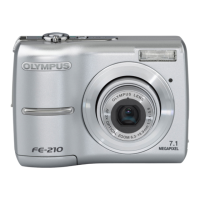

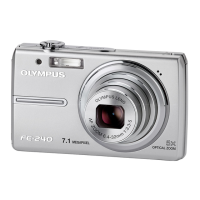
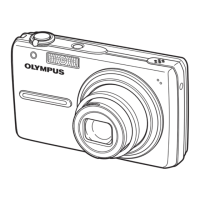



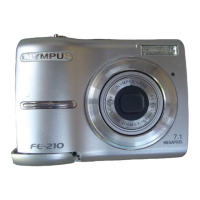
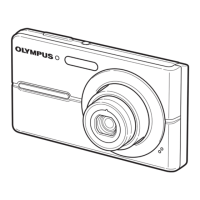


